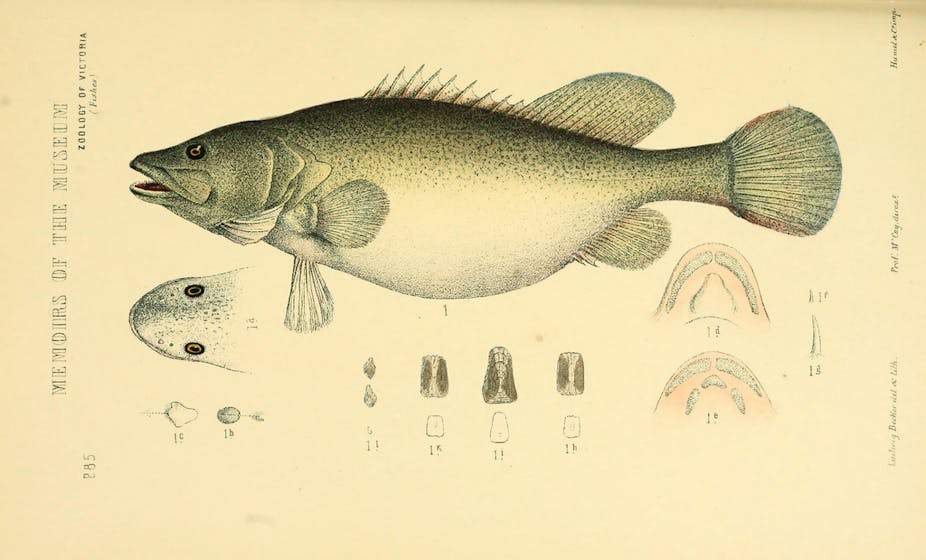The Murray-Darling Basin Authority’s Native Fish Strategy (NFS) is at serious risk of winding up, after NSW announced it is cutting its financial contributions. This is a serious blow to the conservation and management of an iconic group of animals that get little long-term, strategic consideration and funding from state governments.
It also flies in the face of the popularity of fish and fishing to the wider community. The recreational fishing lobby and conservation groups are justifiably concerned.
Annually, about one in five of us goes fishing; more so for Indigenous Australians. It is one of the most popular pastimes in Australia and a large amount of money is spent in its pursuit, whether on fishing gear, bait, boats or accommodation. It is one of those rare, acceptable “primeval” behaviours that appeals to kids and adults alike. For the majority, it also brings people closer to nature, making them appreciate healthy water bodies, and contributing to better conservation and management.
While there is debate about the merits of introduced species, like trout and redfin, there is universal agreement that healthy populations of native fish are a good thing. There are various estimates of the state of the fish in the Murray-Darling Basin. Some say they are at 10% of pre-European numbers. I think that it is closer to 1%, based on my reading of early explorers’ and settlers’ accounts of the number and size of fish that could be caught before environmental degradation.

But the actual percentage is somewhat academic. There is overwhelming evidence that fish numbers of the vast majority of species, including icons like the Murray cod, are a fraction of what they once were.
Some species are close to extinction: 73 of Australia’s approximately 250 species are currently listed as “threatened” under state or national legislation. And, to a large extent, the biomass of native fish has been replaced by introduced species, especially carp. A noxious species, carp is equivalent to the cane toad in the damage it causes and the negative emotions it elicits.
The reasons for the decline of native fish include historical overfishing, habitat change, river regulation, poor water quality, barriers to movement and the introduction of non-native species. But in many cases, we don’t know the actual cause for shrinking distribution and loss of populations. It is likely that multiple factors over time have contributed to this sad state of affairs.
We are also still in the early days of understanding how fish live, feed, breed and respond to the conditions that nature and humans throw at them. The increase in our knowledge of their ecology is struggling to keep pace with the steep decline of our fish.
It is unfortunate in some ways that we have no ongoing commercial fisheries of native species, but the numbers are not good enough to sustain such fishing pressure. So, unlike marine species, which support many commercial fisheries, freshwater fish tend to receive a tiny amount of funding compared to their marine counterparts. The federally funded Fisheries Research and Development Corporation, for example, doles out the vast majority of its funds to marine fisheries.

And that is where the Native Fish Strategy (NFS) comes in. Over more than 10 years, the Murray-Darling Basin Authority’s foresight has put native fish up front, recognising fish as important in their own right and as sentinels for the health of our rivers. Some species, such as Murray cod, are like the lions of our waterways, and their demise affects all aspects of freshwater food webs of the Murray-Darling Basin. Other species are critical as food for larger fish and water birds.
The NFS has a long-term plan, realising that rehabilitation and restoration of our rivers takes time. It includes research to increase our understanding of what species and populations need to persist; conservation to restore populations of threatened species, like trout cod; management, to improve conditions in our rivers so that fish can carry out their life cycles, like improving fish passage; and education, so that the next generation continues to care for our freshwater environment.
The NFS’s work has only really just begun, and has just started to show dividends. Cutting funding for native fish research, conservation and management does not make sense in any but purely financial terms. The NFS should be recognised for what it is: a key plank in restoring health to the rivers of the Murray-Darling Basin. It should be supported at all costs.

